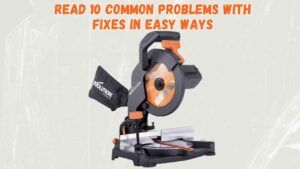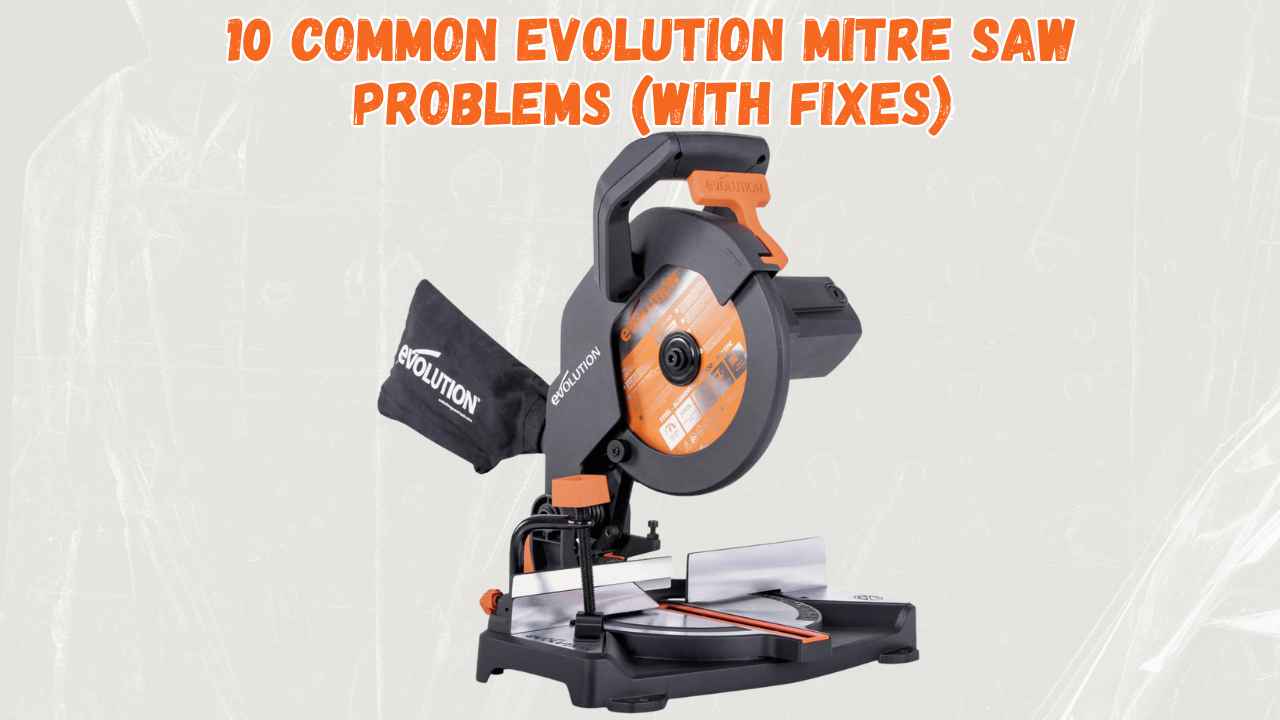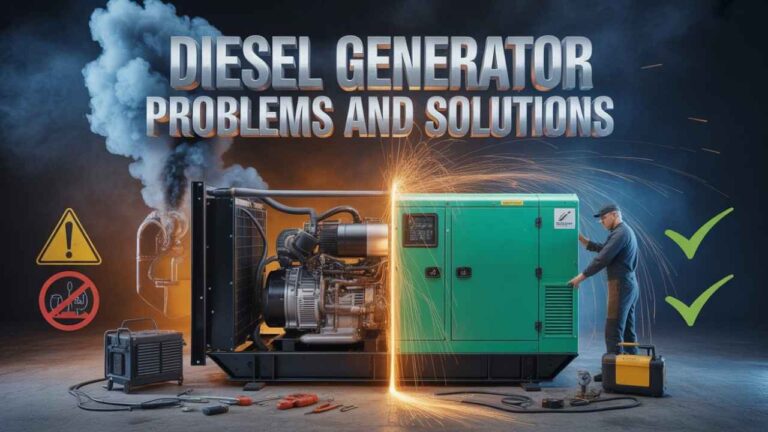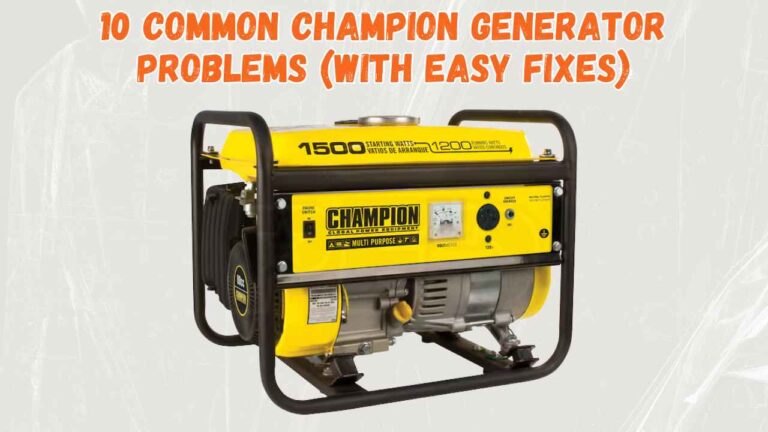Struggling with your Evolution Mitre Saw?
You’re not alone! Like any tool, it can face issues over time. In this guide, we’ll cover 10 common Evolution Mitre Saw problems and their simple fixes, so you can get back to cutting with precision in no time.
Whether you’re a DIYer or a pro, these tips will save you time and frustration.
Evolution Mitre Saw Problems (Short Overview)
Evolution Mitre Saw problems can range from blades not spinning properly to inaccurate cuts or motor issues.
These problems usually happen because of dull blades, loose parts, or lack of maintenance.
Don’t worry most issues are easy to fix with regular care and quick checks before use. Stay proactive, and your saw will work like a charm!
Read 10 Common Problems With Fixes In Easy Ways…

1. Blade Misalignment
Blade misalignment is a common issue with Evolution Mitre Saws, leading to uneven or inaccurate cuts.
Causes
- Incorrect setup during assembly
- Loose or worn-out blade, fence, or alignment screws
- Frequent use without maintenance
Fixes
- Check and tighten all screws and alignment points regularly
- Re-calibrate the blade and fence following the manufacturer’s instructions
- Replace worn-out parts to maintain precision and safety safety
2. Loose Fence
A loose fence on an Evolution mitre saw can cause inaccurate cuts and affect your overall project quality.
Causes
- Frequent use leading to wear and tear.
- Screws or bolts holding the fence may loosen over time.
- Improper alignment or adjustments during setup.
Fixes
- Regularly inspect and tighten all screws and bolts on the fence.
- Check the alignment and recalibrate the fence as per the user manual.
- Use thread-locking adhesive on screws to prevent them from loosening during use.
3. Motor Overheating
A common issue with Evolution Mitre Saws is motor overheating, which can affect performance and shorten the tool’s lifespan.
Causes
- Overloading the saw with heavy-duty tasks.
- Dust and debris buildup in the motor.
Fixes
- Avoid running the saw continuously for long periods; let it cool down between uses.
- Clean the motor regularly to remove dust and debris.
- Use the appropriate blade and settings for the material to reduce strain on the motor.
4. Dull Blade
A dull blade is a common issue with Evolution Mitre Saws that can impact cutting performance and precision. Over time, frequent use can wear down the blade, making it less effective and causing rough or uneven cuts.
Causes
- Regular wear and tear from constant usage.
- Cutting through tough or improper materials.
Fixes
- Regularly inspect the blade for signs of dullness or damage.
- Replace the blade with a new, compatible one when it becomes worn.
- Ensure you’re using the correct blade for the material you’re cutting to extend its lifespan.
Read Also:
Dewalt dw788 scroll saw problems
5. Power Failure
A power failure is a common issue with Evolution Mitre Saws that can interrupt your work.
Causes
- Faulty power cord or plug
- Overloaded motor due to extended use
- Loose internal wiring
Fixes
- Check and replace a damaged power cord or plug.
- Allow the saw to cool down if overheated before restarting.
- Inspect and tighten any loose wiring or connections.
6. Poor Dust Collection
One common issue with Evolution Mitre Saws is poor dust collection.
This can lead to a messy workspace and make it harder to maintain a clean, safe environment while cutting.
Dust buildup can also affect the saw’s performance over time, potentially shortening its lifespan.
Causes
The primary cause is often an inefficient dust port design or a lack of compatibility with standard dust extraction systems. Smaller ports or weak airflow can fail to capture all the dust generated during cutting.
Fixes
To address this, ensure your saw is connected to a compatible shop vacuum or dust collection system.
Consider upgrading to a more powerful vacuum or using an aftermarket dust collection attachment designed for better efficiency.
Regularly cleaning the dust port and surrounding area can also improve performance.
7. Noisy Operation
A noisy Evolution Mitre Saw can be frustrating and disruptive during use.
Excessive noise often indicates underlying issues with the saw’s components, such as a misaligned blade or worn-out motor bearings.
These problems not only affect performance but can also lead to long-term damage if left unchecked.
Causes:
- Misaligned or dull blade causing uneven cutting and vibration.
- Worn-out motor bearings leading to loud, grinding sounds.
- Loose or improperly assembled parts creating additional noise.
Fixes:
- Ensure the blade is properly aligned and sharpened. Replace it if necessary.
- Inspect the motor bearings and replace them if they show signs of wear.
- Tighten all screws and parts to reduce vibrations and unwanted noise.
8. Uneven Cuts
Experiencing uneven cuts with your Evolution Mitre Saw can be frustrating, especially when precision matters.
Causes
- The blade may not be installed correctly, leading to instability during operation.
- Misalignment of the saw table or fence can throw off the cutting angle.
- A dull or damaged blade can also cause uneven results.
Fixes
- Check and realign the saw table and fence to ensure they are perfectly square.
- Inspect the blade installation and secure it properly.
- Replace or sharpen the blade if it’s worn out or damaged. Regular maintenance is key to preventing uneven cuts.
9. Trigger Malfunction
A common issue with Evolution Mitre Saws is a trigger malfunction, which can prevent the saw from starting or operating properly.
Causes
- Dust or debris clogging the trigger mechanism.
- Faulty wiring or loose connections.
- Damage from prolonged usage or mishandling.
Fixes
- Clean the trigger area thoroughly to remove dust or debris.
- Check for loose wires and ensure proper connections.
- If the problem persists, replace the trigger or consult a professional for repairs.
10. Blade Stalling
One common issue with Evolution Mitre Saws is blade stalling, where the blade slows down or stops during cuts.
This can disrupt your work and affect the quality of your cuts. Blade stalling often occurs due to improper usage or mechanical issues, but it can be resolved with simple steps.
Causes
Blade stalling may happen if the saw is cutting material that exceeds its capacity or if the blade is dull and unable to cut efficiently.
Additionally, excessive pressure on the saw or motor strain from improper alignment can also cause this issue.
Fixes
To fix blade stalling, ensure you are using the right type of blade for the material and replace dull blades regularly.
Avoid forcing the saw—let the blade do the cutting. Check and align all components properly, and keep the saw clean and well-maintained to ensure smooth operation.
FAQs
What is the price of the Evolution Mitre Saw?
The price of the Evolution Mitre Saw varies depending on the model, typically ranging from $120 to $300.
Is Evolution a good mitre saw?
Yes, Evolution mitre saws are known for their durability, precision, and ability to cut through various materials effectively.
What is the difference between Evolution green and orange?
The green range is designed for industrial use, offering heavier duty performance, while the orange range is aimed at general trade and DIY users.






[…] 10 Common Evolution Mitre Saw Problems (With Fixes) […]